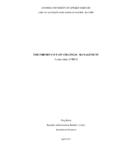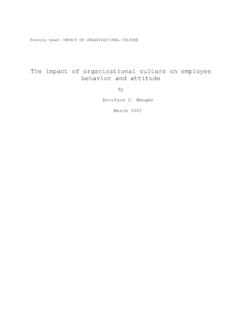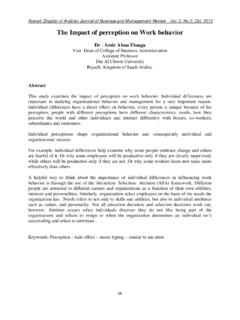Transcription of ORGANIZATIONAL CULTURE & EMPLOYEE BEHAVIOR
1 ORGANIZATIONAL CULTURE & EMPLOYEE BEHAVIOR Case study LAHTI UNIVERSITY OF APPLIED SCIENCES Degree programme in Business Information Technology Thesis Spring 2015 Tianya LI Lahti University of Applied Sciences Degree Programme in Business Information Technology Tianya LI: ORGANIZATIONAL CULTURE & EMPLOYEE BEHAVIOR Case Study Bachelor s Thesis in Business Information Technology, 44 pages, 3 pages of appendices Spring 2015 ABSTRACT Organizations are among the key units of the society. During their establishment and development, a specific kind of ORGANIZATIONAL CULTURE eventually appears. The purpose of ORGANIZATIONAL CULTURE is to improve solidarity and cohesion, and to stimulate employees' enthusiasm and creativity to improve the organization s economic efficiency. In addition, ORGANIZATIONAL CULTURE greatly influences EMPLOYEE BEHAVIOR .
2 The aim of this study is to find out how ORGANIZATIONAL CULTURE affects EMPLOYEE BEHAVIOR . It is important to understand that in order to improve the organization s business management and let the ORGANIZATIONAL CULTURE have the right impact on employees. The results of the study indicate that ORGANIZATIONAL CULTURE mainly impacts motivation, promotes individual learning, affects communication, and improves ORGANIZATIONAL values, group decision making and solving conflicts. Keywords: ORGANIZATIONAL CULTURE , ORGANIZATIONAL BEHAVIOR , EMPLOYEE BEHAVIOR . CONTENTS 1 INTRODUCTION 1 Background 1 Statement of the problem 1 Overview of the thesis 2 2 RESEARCH METHODOLOGY 4 Research question 4 Research methods 4 Research framework 5 Data collection and data analysis 5 3 LITERATURE REVIEW 7 ORGANIZATIONAL CULTURE : an overview 7 ORGANIZATIONAL CULTURE and its dimensions 9 Power Distance 9 Individualism and collectivism 10 Masculinity and Femininity 11 Uncertainty avoidance 13 Long-Term Orientation 14 Indulgence versus Restraint 14 ORGANIZATIONAL BEHAVIOR 14 Individual level variables 15 Group level variables 15 ORGANIZATIONAL system level variables 15 ORGANIZATIONAL CULTURE and ORGANIZATIONAL BEHAVIOR 16 Advantages ORGANIZATIONAL CULTURE has on BEHAVIOR 17 4 CASE STUDY 19 Case Overview 19 ORGANIZATIONAL CULTURE 19 Symbols 20 Rituals 21 Values 23 CULTURE dimensions measurement 23 Power distance 24 Individualism and collectivism 25 Uncertainty avoidance 27 Masculinity and femininity 28 Long-term orientation 29 Indulgence and restraint 30 5 DATA ANALYSIS 31 6 CONCLUSION 39 7 DISCUSSION 41 Limitations
3 41 Validity and reliability 41 Suggestions for future study 42 REFERENCES 43 APPENDICES 45 LIST OF FIGURES Figure 1: Structure of the thesis 3 Figure 2: The "Onion": Manifestations of CULTURE at different levels of depth 8 Figure 3: Structure diagram of ORGANIZATIONAL CULTURE 20 Figure 4: Logo of case company 21 Figure 5: Relations between dimensions and a given value 23 Figure 6: ORGANIZATIONAL structure of the case company 24 LIST OF TABLES Table 1: Key differences between small- and large-power-distance cultures .. 10 Table 2: Key differences between collectivist and individualist cultures .. 11 Table 3: Key differences between feminine and masculine cultures .. 12 Table 4: Key differences between weak and strong uncertainty avoidance .. 14 Table 5: Interviewees answers concerning power 32 Table 6: Interviewees answers concerning individualism and collectivism.
4 33 Table 7: Interviewees answers concerning masculinity and femininity .. 34 Table 8: Interviewees answers concerning uncertainty avoidance .. 35 Table 9: Interviewees answers concerning long-term orientation .. 37 Table 10: Interviewee's answers from question theme indulgence and restraint .. 38 1 1 INTRODUCTION Background CULTURE has been defined in many different ways and by many different theorists. For instance, according to Geert et al (2010) it is the collective programming of the mind that distinguishes the members of one group or category of people from others . Kotter and Heskett (1992) noted that CULTURE is a set of beliefs, values and behaviors commonldy held by a society, being derived from social anthropology as a framework for understanding primitive societies . Finally, Deal and Kennedy (1982) defined CULTURE in short as the way we do things around here.
5 When establishing and developing a company or other organization, an internal CULTURE will develop step by step. The purpose of its existence is to improve solidarity and cohesion, stimulate employees' enthusiasm and creativity, and to improve the economic efficiency of an organization. Like cultures in general, ORGANIZATIONAL cultures are complex and unique. They are based their individual history, leadership and workforce. Hence, in order to improve management and let an ORGANIZATIONAL CULTURE have the right effect on employees, it is important to understand how ORGANIZATIONAL cultures affect EMPLOYEE BEHAVIOR . Statement of the problem For an organization, EMPLOYEE is its basic constituent units, and CULTURE is the common value and code of conduct shared by the employees. It could give can provide employees with a relaxed working environment with harmonious interpersonal relationships in order to give full play to their ability.
6 A corporate CULTURE allows employees to have a sense of mission and feel responsibility, and work towards the overall goal of the company. The competitiveness of enterprises is not only reflected in the technology, but also in their corporate CULTURE . A positive ORGANIZATIONAL CULTURE can promote healthy development of an enterprise, and actively mobilize the performance of employees, 2 and make them work with more enthusiasm. Moveover, it may improve production efficiency. In short, the benefits of a positive organiziational CULTURE are self evident. The priority of an enterprise is to increase the loyalty of its customer base. Therefore, a good corporate image must be established. In other words, a good corporate image brings good economic returns, and a good corporate image is dependent on good ORGANIZATIONAL CULTURE . Overview of the thesis This study consists of six chapters.
7 First, the research problem is in traduced. In addition, this section provides a contextual background and outlines some of the main aspects of ORGANIZATIONAL cultures and BEHAVIOR . Finally, the importance of the research problem is explained and the research question is introduced. Chapter two explores the research approach adopted in this study, includes the research question, defines the research method, and describes the research framework, and data collection and analysis. Chapter three presents a literature review, which introduces previous studies about ORGANIZATIONAL CULTURE , EMPLOYEE BEHAVIOR in organizations, and the relations among them. Chapter four includes a case study on the effects of ORGANIZATIONAL CULTURE . The chapter presents an overview of the case company, discusses ORGANIZATIONAL CULTURE and introduces CULTURE dimension measurement.
8 Chapter five introduces the data collection method and data analysis. Data will be collected from interviews and observation. Some of the employees and supervisor from management levels in the case company will be interviewed. Chapter six presents the results of the data analysis, findings and a conclusion to the research question. The factors that influence the EMPLOYEE BEHAVIOR in the case company will be summarized to give an answer to the research question. 3 Finally, chapter seven outlines the limitations, the validity and reliability of the study, and introduces suggestions for future studies. The following figure (Figure 1) shows the structure of the thesis: Figure 1: Structure of the thesis Chapter1 INTRODUCTION Background context about enterprise CULTURE and BEHAVIOR , statement of research problem, overview of the research Chapter 2 RESEARCH METHODOLOGY Explores the research approach and includes the research question, research method, research framework, data collection and analysis Chapter 3 LITERATURE REVIEW Previous studies about enterprise CULTURE and BEHAVIOR , CULTURE dimensions, and the relationship among them Chapter 4 CASE STUDY Case company overview, ORGANIZATIONAL CULTURE , and CULTURE dimension measurement Chapter 5 DATA ANALYSIS Findings and the conclusion Chapter 6 CONCLUSION Chapter 7 DISCUSSION Limitations, validity and reliability.
9 And suggestions for future studies 4 2 RESEARCH METHODOLOGY Research question It is important to examine how enterprise CULTURE may affect EMPLOYEE BEHAVIOR . The study therefore focuses on the CULTURE dimensional factors that influence EMPLOYEE BEHAVIOR and may improve work efficiency and productivity. Thus, the research question is: How does ORGANIZATIONAL CULTURE affect EMPLOYEE BEHAVIOR ? Research methods In this study, the research will be conducted using a qualitative research method. When applying qualitative methods, the aim is to reach a thorough understanding of the object of study based on people s BEHAVIOR , feelings and experiences. The data is often collected by interviews rather based on statistics and numbers. As the present study focuses on people, their behaviors and how ORGANIZATIONAL CULTURE affects their BEHAVIOR , the research question cannot be answered on the basis of numerical data.
10 Thus, qualitative research methods are considered suitable for the purposes of this study. This is a deductive, explanatory study. The deductive approach is concerned with examining a hypothesis based on existing theory. By applying relevant methodology, a given study either confirms or disproves a hypothesis. Generally, studies using deductive approach follow the following stages: Theory, Hypothesis, Observation, and Confirmation. (Woodwell, 2014) The hypothesis deduced by the researcher is that the EMPLOYEE BEHAVIOR is affected by the three levels of the CULTURE : symbols, rituals, and values. In addition, values consists with six CULTURE dimensions, power distance, individualism and collectivism, masculinity and femininity, uncertainty avoidance, long-term orientation, and indulgence and restraint. 5 Research framework In this research framework, the concepts are based on the background information, the literature review and the case study.













